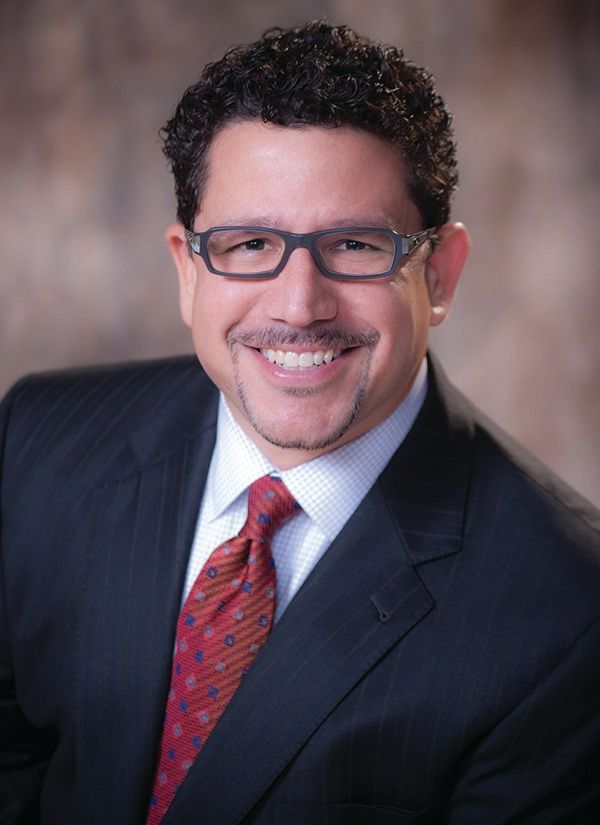Top 5 Disruptive Trends to Watch in Healthcare
What these healthcare industry disruptors are, and how they could impact cost and quality of care.
Friend

Buckey

Barakat

Duffant

Kumar

Tremmel Freeman

Valenti

Daniel

Coleman

Over the next five years, industry experts predict big changes that will significantly impact managed care. These range from state governments getting more involved in healthcare to more online retailers throwing their hat in the healthcare ring.
“As industries continue to blur, traditional healthcare companies will need to break down silos to drive value across the industry ecosystem,” says David Friend, MD, MBA, chief transformation officer and managing director, The BDO Center for Healthcare Excellence & Innovation, a healthcare accounting and consulting firm. “To compete with disruptors, healthcare companies will need to capitalize on data, maximize profitability, and innovate patient care all while managing growing risk in the areas of patient privacy and data security.”
It's a daunting challenge, but preparation can help ensure success. Here are some of the biggest areas of disruption that could impact your organization.
Online retailers
This year a flurry of discussions and deal-making occurred between retailers and healthcare organizations, Friend says. This includes:
- Walmart’s reported early-stage talks to acquire Humana;
- The Amazon, JPMorgan, and Berkshire Hathaway venture that aims to transform its employees’ healthcare; and most recently,
- Amazon’s billion-dollar acquisition of online pharmacy PillPack.
Other companies disrupting healthcare include big retail pharmacy chains such as Walgreens and CVS Caremark Corp., which are combining their thousands of stores and walk-in clinics with their e-commerce systems to create new digital healthcare delivery platforms, says Kim A. Buckey, vice president, Client Services, DirectPath, LLC, which helps employees become better healthcare consumers. For example, Walgreens partnered with MDLive in 2015 to facilitate telemedicine offerings to consumers.
Health-specific retailers that have entered the space, such as FSAStore.com and healthwarehouse.com, offer price transparency and product delivery to consumers who are price-sensitive, Buckey says.
Another notable entrant is large employers that are working alongside or acquiring emerging health and wellness companies, Buckey says. UnderArmour, for instance, has invested heavily in wearable devices and, with the acquisition of companies such as MapMyFitness and MyFitnessPal, has become the major player in digital fitness. Under the umbrella of its Connected Fitness segment, UnderArmour has access to tremendous amounts of health data.
Traditional technology entities are building healthcare apps, wearables, and other connected devices, and consumers are using them to track their health progress and feed data back to their provider, payer, or both, says Friend. “Technology has brought healthcare to consumers’ fingertips, putting them at the nucleus of care and blurring the definition of a healthcare organization.”
Retailers are partnering with pharmacies, to share data and reach more consumers, he adds. Insurers are partnering with pharmaceutical manufacturers to leverage patient data to improve outcomes and lower health costs. “Everyone is getting into everyone’s business and will continue to do so to provide improved patient outcomes and ensure survival in a consumer-centric industry.”
The most valuable resource in healthcare is data, which online retailers-with their growing consumer health and wellness products-have in spades, says Friend. “Access to data and the ability to capitalize on that data is key to developing consumer-centric models of care, improving patient outcomes, and lowering costs.”
Online retailers like Amazon are entering the healthcare industry on other fronts, Buckey says. For example, they are selling personal health equipment such as walkers and canes directly to consumers and medical supplies such as gloves and syringes to providers. “Because of their experience negotiating low prices, ability to deliver products directly to consumers on a timely basis, and its built-in price transparency, they are well-positioned to disrupt the healthcare delivery landscape in particular,” Buckey says. For example, online retailers give consumers the opportunity to order medications or supplies online and have them delivered to their home or arrange for pickup at a local store.
“We’ve already seen a shift away from brick-and-mortar stores in other sectors; it was only a matter of time before we saw something similar with healthcare,” Buckey says. “Healthcare services and supplies are just as much a commodity as electronics, clothing, or even cars. With more purchasing power leaning toward consumers, it’s no surprise to see them opting for more convenient options when shopping for the healthcare treatments, services, and products they need.”
Personalized, targeted therapies
A new treatment, called immune effector cell therapy, allows physicians to harvest a patient’s T cells (a type of white blood cell), re-engineer them to target cancer cells by equipping them with receptors-proteins placed on the surface of T cells that allow them to bind more effectively to cancer cells-and then reintroduce them into that patient’s immune system, says Richard R. Barakat, MD, MBA, physician-in-chief and director of cancer, Northwell Cancer Institute. The institute is part of Northwell Health in Lake Success, New York, which is the state’s largest healthcare provider and private employer and treats 2 million patients annually. The engineered cells multiply in the patient’s body and recognize and kill cancer cells that harbor the receptor.
The most advanced therapy in clinical development in this space is chimeric antigen receptor T-cell (CAR T-cell) therapy.
The FDA has approved two CAR T-cell therapies:
- Yescarta (axicabtagene ciloleucel), manufactured by Kite Pharma (which was recently acquired by Gilead), is approved for patients with refractory diffuse large B-cell lymphoma.
- Kymriah (tisagenlecleucel), from Novartis, is approved to treat acute lymphoblastic leukemia in patients under age 25 years.
“These two treatments target small populations who have limited to no further treatment options, but [the treatments] pose challenges to the U.S. healthcare system due to their high upfront costs, uncertainty of effectiveness, and potential adverse events,” says Brian Duffant, vice president, BluePath Solutions, a market access and health outcomes consulting firm.
CAR T-cell therapy is intended to be delivered as a one-time treatment. The cost of therapy for Yescarta (with a wholesale acquisition cost of $373,000-the list price set by the manufacturer) and Kymriah ($475,000) is front-loaded. “This may result in short-term budget impact challenges, which are particularly acute for smaller payers and employers,” Duffant says. “The current U.S. healthcare system doesn’t have existing infrastructure for this type of cost dynamic, and will require innovative solutions such as payment over time, risk-share agreements, and indication-specific pricing.”
Although expensive, Amit Kumar, PhD, CEO and president, ITUS Corp., a cancer diagnostics and therapy company and board member of the American Cancer Society, says the overall impact of CAR T-cell therapies to the healthcare system is modest right now due to the small number of conditions it can treat. “Payers, including Medicare, are already working with providers and therapy developers to evaluate and institute new models for reimbursement,” he says. For example, CAR T-cell therapies may not be reimbursed unless there is an objective measure of efficacy.
Barakat says some payers already have policies for these two treatments. “Inpatient costs will likely be bundled into the total cost of the hospital stay,” he says. “While many institutions will likely launch their CAR T therapies in an inpatient setting due to the potential of significant toxicities … these therapies could possibly be performed in an outpatient setting as a pretreatment with an interleukin-6 (IL-6) receptor blockade-which could potentially result in less toxicity.”
Social determinants of health
Social determinants of health include economic stability, education, health and healthcare, neighborhood and built environment, and social and community context, according to Healthy People 2020, which provides 10-year national objectives for improving Americans’ health. “These are the conditions in which people are born, grow, live, work, and age, as well as the circumstances that impact their health,” says Lori Tremmel Freeman, MBA, CEO, National Association of County and City Health Officials, which advocates for local health departments. “Social determinants of health undergird many current healthcare challenges, including obesity, heart disease, diabetes, and depression.”
While genetics plays a role in an individual’s overall health, most health outcomes are the result of circumstances outside the healthcare system. “The conditions in which someone lives, whether they have transportation to a clinic when needed, their support network, and other factors beyond the doctor’s office are as important to an individual’s overall health and well-being as being treated for an illness,” says Joseph Valenti, MD, board member, The Physicians Foundation, an organization that seeks to help physicians deliver high-quality care. “As the healthcare system effectively addresses these issues, the overall price of healthcare in the United States will decrease and people will generally be healthier.”
Some states, insurers, and hospitals are already factoring social determinants into healthcare by doing things like ensuring patients have adequate housing and access to needed resources and programs.
Freeman says more attention to social determinants would provide a more balanced approach to health.
From a public health perspective, she says healthcare can be categorized at three levels:
- Primary, focused on disease prevention;
- Secondary, treating disease in the early stages; or
- Tertiary, treating the effects of a disease or illness.
Considering diabetes as an example, primary care would include a focus on healthy lifestyle, secondary care would involve monitoring of blood levels and medication, and tertiary care could include amputation.
Primary, secondary, and tertiary care can be targeted at the individual, interpersonal, organizational, community, or public policy level, Freeman says. Naloxone, a medication designed to rapidly reverse opioid overdose, for example, is tertiary care at an individual level. On the other hand, given that unemployment is thought to contribute to patterns of opioid use, a strategy of increasing job opportunities becomes primary care at a community level. By focusing on the social determinants, organizations can better address population health problems.
Social determinants of health could impact how the healthcare industry conducts business. Instead of concentrating on tertiary care for patient populations only, healthcare could participate more in community health, Freeman says. Eventually, as social determinants of health become a greater part of the healthcare portfolio, tertiary care spending would decrease while quality of life would increase for affected communities.
In many places, this has already begun, as hospitals and health insurers work with local health departments around community health concerns, she says. By law, providing community benefit has been central to the tax-exempt status of nonprofit hospitals. The ACA’s explicit requirement for nonprofit hospitals to consider input from those with public health expertise in the development of hospital community health needs assessment and implementation strategies has increased local collaborations around social determinants of health.
Artificial and augmented intelligence
As more electronic health data becomes available, artificial intelligence (AI) can unlock the potential for that information to be used to improve healthcare. “No more will ‘doctor knows best’ be sufficient,” says Jodi Daniel, a partner in Crowell & Moring’s Healthcare Group and a member of the firm’s Digital Transformation Practice. “Clinicians will need to apply their training and experience along with data and sophisticated systems that can identify new information that may not have been available or transparent before. This could lead to significant improvements in diagnosis and treatment and create efficiencies for provider and patient interactions and administrative functions.”
AI applications include:
- Population health management, in which AI software can help clinicians and insurers better identify and prioritize patients to provide the right level of resources to minimize costs and improve patient outcomes, Daniel says.
- Diagnostics, in which AI is assisting with diagnoses. For example, this year, the FDA approved AI-based tools for detecting wrist fractures and diabetic retinopathy in patients, decreasing time from onset to treatment.
- Patient care, in which it can help providers determine the treatment approach. In February, for example, the FDA approved clinical decision support software that uses AI algorithms to analyze images for indicators associated with a stroke, Daniel says.
Growth in the AI health market is expected to reach $6.6 billion by 2021-a compound annual growth rate of 40%, according to Accenture. Several trends are driving that growth:
- The continued, unmanageable increase in healthcare costs. “Value-based payment requires that clinicians have actionable data to manage patients and that health plans have data and tools to evaluate performance and health outcomes,” says Daniel.
- Concerns continue to grow regarding physician burnout and medical labor shortages. “AI software can reduce the burden of providers when doing documentation and data management, and AI tools can help triage patients so that physician time is available to patients with the greatest need,” Daniel says.
- Technology advancements across all industries have resulted in patients changing their expectations of their healthcare interactions. “Individuals are used to quick responses, electronic access to information, and the ability to be more engaged in decision making,” Daniel says. “There will be a growing need for the healthcare sector to adopt AI technology to streamline services and to improve quality of those services.”
- A thirst for improving the understanding of complex diseases and treatments and conducting research. “AI will be an important tool for analyzing vast amounts of data to develop future treatments,” she says.
Ultimately, Daniel says the single-most significant potential for AI is its power to change the standards of practice. “Better analytical tools for improved diagnosis and treatment and more data from outside the clinical care setting such as patient-generated health data and social determinants data can provide a more accurate picture of the patient and improve care decisions and outcomes,” she says.
State government interventions
State governments have been operating the Medicaid program, which has become a fundamental driver of U.S. healthcare policy and service delivery, since 1965. Medicaid now covers 74 million people, including paying for more than half of the country’s births and more than 65% of nursing home residents.
Thirty three states and the District of Columbia have expanded Medicaid to cover childless adults under the ACA. Legislation introduced by U.S. Sen. Brian Schatz (D-Hawaii) and U.S. Rep. Ben Ray Luján (D-New Mexico 3rd District) in October 2017 titled the State Public Option Act, would create a Medicaid-based public healthcare option on the insurance marketplace. Since then several states, including Nevada, Iowa, Massachusetts, Minnesota, Missouri, New Jersey, and Washington, have introduced Medicaid buy-in proposals to cover more uninsured or underinsured individuals, says Pamela Coleman, senior consultant, Sellers Dorsey, a national healthcare consultancy.
Having worked with the Medicaid program since the mid-1980s, Coleman has seen it evolve from one where states passively paid claims to one where the emphasis is on paying for positive healthcare outcomes. “The majority of states have implemented managed care models where health plans are put at risk for poor patient outcomes,” she says. “Performance measurement and continuous quality improvement are central to these models. Many healthcare delivery innovations have come from state Medicaid programs.”
Because states must balance their budgets, unlike the federal government, they must innovate to ensure their programs are sustainable and produce results for their Medicaid population, Coleman says. “In order to innovate, state policymakers must disrupt the status quo and develop and implement new ways to finance their Medicaid programs, reimburse providers by paying for value, not volume, and work with health plans to ensure providers are available to deliver healthcare services throughout a state.”
Given the current political climate, Coleman views Medicaid for All as more attainable than the Medicare for All proposal. Medicaid for All proposes the option for individuals to buy into Medicaid coverage and be eligible for premium subsidies and reduced cost sharing. In contrast, Medicare for All, as proposed by U.S. Sen. Bernie Sanders (D-Vermont), would create a national insurance system for single-payer coverage for all U.S. citizens.
A recent analysis by The Mercatus Center estimated that this proposal would lead to a $32.6 trillion increase in federal spending over a 10-year period. A Medicaid for All buy-in program would likely cost the federal government much less, says Coleman.
Also, unlike Medicare, states administer Medicaid, which covers populations from newborns to frail seniors and includes many individuals with mental health conditions and substance abuse disorders.
“Medicaid is leading the fight on the opioid epidemic by requiring health plans to develop innovative interventions to address problems at the community level,” Coleman says. “Medicaid initiatives that focus on social determinants of health such as housing, nutrition, obesity, and education are also expanding.”
As the ultimate safety net provider, Medicaid faces continuous challenges to provide quality services to beneficiaries while keeping costs down. New flexibilities offered through managed care models and waivers allow for payment of such things as minor home modifications for persons with disabilities, air conditioners for persons with asthma, and supportive employment for persons with intellectual disabilities. “These interventions are far more cost effective than traditional healthcare services and promote personal independence,” Coleman says.
In order to receive federal funding, states must provide a core set of services and beneficiary coverage. To manage these expenditures, states have developed creative solutions to reform healthcare service delivery, such as accountable care systems and value-based payment models. “These transformations can be truly disruptive as Medicaid will no longer pay providers on the basis of volume, but rather on the basis of value,” Coleman says
Whether states adopt Medicaid for All strategies, they will continue to reform Medicaid practices to promote quality and cost-effective delivery, she says. “Large national Medicaid managed care organizations are agreeing to enhanced performance requirements and states are enacting more sophisticated and comprehensive oversight of managed care contracts.”
Karen Appold is a medical writer in Lehigh Valley, Pennsylvania.

Chief Pharmacy Officer Jason R. Smith on the Challenges Health Systems Face
May 28th 2025Jason R. Smith, Pharm.D., appointed as chief pharmacy officer in February 2025 for the University of Rochester Medical Center, talks about building a stronger workforce, managing drug shortages and keeping up with changes in regulations because of the new administration.
Read More
In the Scope of Virtual Health and the Future of “Website” Manner, Per Ateev Mehrotra
August 10th 2023Briana Contreras, an editor of Managed Healthcare Executive, had the pleasure of catching up with MHE Editorial Advisory Board Member, Ateev Mehrotra, MD, MPH, who is a professor of healthcare policy at Harvard Medical School and an Associate Professor of Medicine and Hospitalist at Beth Israel Deaconess Medical Center.
Listen
David Calabrese of OptumRx Talks New Role, Market Insulin Prices and Other Topics 'On His Mind'
April 13th 2023In this month’s episode of the "What's On Your Mind podcast," Peter Wehrwein, managing editor of MHE connects with the now Chief Clinical Officer of OptumRx Integrated Pharmacies, David Calabrese. In this conversation, David touches on his transition in January as OptumRx’s former chief pharmacy officer and market president of health plans and PBMs to his new role as Chief Clinical Officer where he now focuses more on things such as specialty pharmacy to home delivery — with an overall goal of creating whole-patient care. Throughout the conversation, Calabrese also touched on the market’s hot topic of insulin prices and behavioral health services within the OptumRx community, among other topics.
Listen